I’m on the lookout for a new flat in Berlin again and i still have to recover from the discovery that prices have increased fast and implacably, at least in the Prenzlauerberg area. Which brought back to my mind a project i discovered while visiting the Visualizar workshop at Medialab Prado last November (more Visualizar stories).
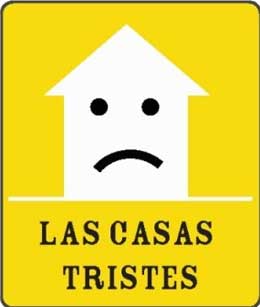 Casastristes.org, by Mar Canet, Gerald Kogler, Jordi Puig, explores housing problems in Spain. Its objective is to serve as an information and resources exchange platform in line with the Web 2.0 philosophy, through the creation of a reliable public database of empty houses in Spain.
Casastristes.org, by Mar Canet, Gerald Kogler, Jordi Puig, explores housing problems in Spain. Its objective is to serve as an information and resources exchange platform in line with the Web 2.0 philosophy, through the creation of a reliable public database of empty houses in Spain.
By providing data visualization and a list of references on the website, the project also aims to offer resources likely to help clarify ambiguous concepts and strengthen the network of citizens, associations, collectives, etc. concerned about housing and on the lookout for a a way to communicate with each other, become visible, and make proposals.
Casastristes.org questions concepts such as “the advantages of buying a home instead of renting”, and highlights the abundance of empty houses in contrast to the generally accepted theory of “a lack of buildable land”. The purpose is to look for solutions given the extremely high percentage of empty homes in Spain, evaluate the reasons so many people do not leave their parents’ home until age 35, and propose alternative housing policies.
I asked interactive designer Mar Canet, a member of Derivart, an interdisciplinary art group whose work focuses on the intersection between art, technology and finance, to tell us more about the project:
Casastristes.org “aims to provide a broad overview of housing problems in Spain, examining both causes and consequences. Its objective is to serve as an information and resources exchange platform in line with the Web 2.0 philosophy, through the creation of a reliable public database of empty houses in Spain.” Last November in Barcelona, I saw another work you collaborated to as part of the collective Derivart. The interactive installation El Burbujometro explores the housing market in Spain as well. Before focusing on Casas Tristes would you mind telling us a few words about El Burbujometro?
A year ago, we started exploring the polemical question “Is there a real estate bubble in Spain?” Apartments were more expensive than ever, some financial analysts were forecasting that the bubble would burst and others were predicting the opposite. Official data showed that the prices of apartments kept getting higher and higher. Starting from this ambiguous situation, and taking the opportunity offered by Javier Duero to participate to the festival Observatori 2007, we came up with the idea to create the Burbujometro, an installation in which Spanish cities are represented as bubbles. Their respective sizes differ according to the price per square meter. Users, equipped with a gun, have to shoot the bouncing bubbles on the screen to discover the price of a home in that particular city.
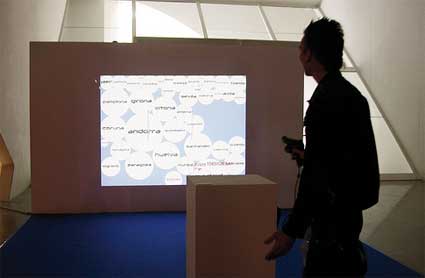
We’ve noticed how some users would shoot with energy, very often asking us if they can make them all explode…. but the bubbles keep on reappearing after a few seconds, triggering a strange (and sometimes frenetic) desire to reach an impossible end: the empty screen coming after a metaphorical burst.
User can see how prices have increased in a general manner all over the country, and not only in big cities like Madrid or Barcelona. The phenomenon impacted also smaller cities which are influenced by their proximity to or by the influence from a bigger city. Through the game people dedicate a relaxed time to the exploration of the price in the whole Spanish holography.
The prices were collected from the well-known estate portal Idealista. For this work, we didn’t want to use statistical data emerging from State organisms, like the Instituto Nacional de EstadÌstica (INE – National Institute of Statistics) or the Banco de Espana (BDE – Bank of Spain). We felt it was extremely important to work with the prices that people would encounter when looking for a house at any time. With Idealista we were able to update the data with more regularity.
.
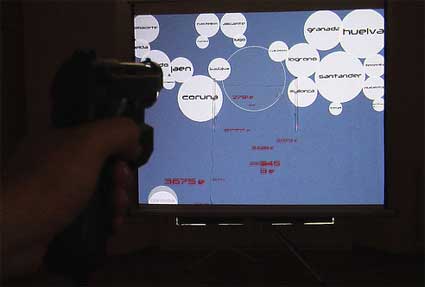 Is Casas Tristes a project which puts the finishing touch to your interest for the estate market in the country?
Is Casas Tristes a project which puts the finishing touch to your interest for the estate market in the country?
We are preparing other projects which have a very different theme. And we still don’t know for sure if Casas Tristes will be the last project that tackles the issue of the real estate.
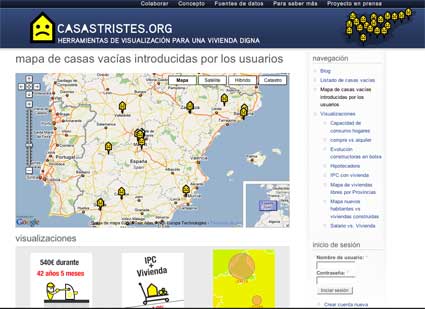 You exhibited Casas Tristes at Medialab Prado in Madrid. Did you have a chance to discuss with visitors of the exhibition? Do you know how they reacted to the project?
You exhibited Casas Tristes at Medialab Prado in Madrid. Did you have a chance to discuss with visitors of the exhibition? Do you know how they reacted to the project?
Yes, during the day of the presentation we had the opportunity to discuss to quite a few people who gave a wide range of opinions and ideas. For example some people warned us that the maps of empty houses could be used by people whose profession is to look for buildings to buy and later sell them to build. We actually have little control on the final use of the database, only the users can decide that.
We nevertheless believe that it is important to open the debate on the housing issue. Similarly other people asked us if we wanted to encourage the illegal occupation of empty houses. Our database aims to raise a discussion. Of course we believe that houses exist for people to live in. New laws are approved such as the one on the Right to have a house, approved on December 17 by the Autonomous Government of Catalonia. The law tries to enforce the renting of empty houses in areas where there is a high demand for flats to rent.
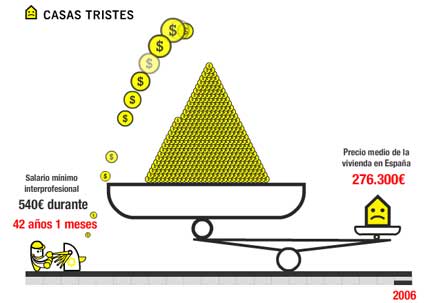 Now that the project is online and working, do you find that the research on data visualization taught you elements that you didn’t suspect would emerge?
Now that the project is online and working, do you find that the research on data visualization taught you elements that you didn’t suspect would emerge?
The projects changed over the production process at the Visualizar workshop in Medialab Prado. The collaborators and tutors (Adrian Holovaty and Ben Fry) had a key role in improving the original idea. Of a great help was also Daniel Remeseiro’s surrender of the Drupal platform casasvacias.org. It was a big change of paradigm for the project as we suddenly found ourselves with the implementation of the system that enabled to visualize houses on the maps and upload them on the web. We were thinking of creating visualization on the theme in order to build up a community around a database made of empty flats and created by its users.
We wanted to use the same aesthetic employed in journalism infography, where data graphics are easy to understand. But we wanted to add a level of interaction that allowed the user to navigate historically in the data, the daily press doesn’t allow you to do that.
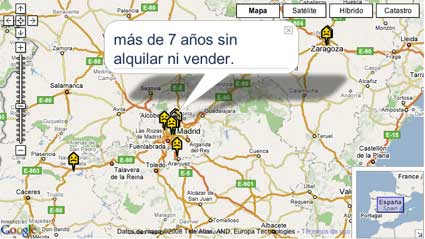 Do you have any plan to develop the project further?
Do you have any plan to develop the project further?
This is only the first step of the project because the theme is very large. For the time being, our main interest is to encourage the participation of users who are invited to add new empty houses to the database and create a community which goes beyond the virtual aspect of the project. For example, by having a walk around their city and spot empty houses and by generating discussion.
We have several visualizations which will be published over the next few months. Among them, let’s highlight the realization of a visualization that uses the data provided by idealista (a weekly compendium of news related to real estate and published in the media). Another visualization we are working on attempts to show the mortgages currently active.
We also have more ambitious ideas but they are long-term ones such as the development of a map which displays the houses built over the last decades and use that data to create an animated evolution (with several levels of zoom) of the houses constructed.
Thanks Mar!
The Burbujometro will be on view at LABoral in Gijon (Spain) as part of Homo Ludens Ludens, an exhibition which will explore play in contemporary culture and society. The show opens on Friday and will run until September 22, 2008.
All images courtesy of Mar Canet Sola.
Related: Santiago Cirugeda’s “Casa de pollo” (Chicken House), a 30 sq meter prototype of urban dwelling.
